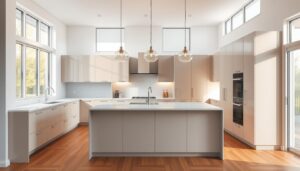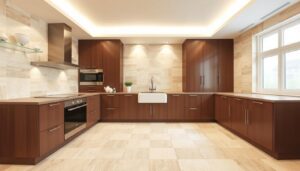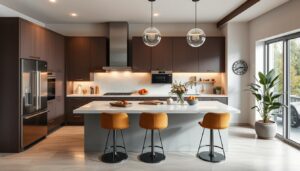Embarking on a kitchen remodel is an exciting project for any homeowner. It represents a significant investment in your property’s value and your daily quality of life. While the potential rewards are immense, the journey demands careful consideration.
A successful transformation requires meticulous planning. This guide provides a clear roadmap for your project, from initial concept to the final beautiful result. We will cover all the essential steps to ensure your vision becomes a reality.
Understanding the process is crucial for managing expectations, budget, and timeline. With the right approach, you can create a stunning, functional space that becomes the heart of your home for years to come.
Key Takeaways
- Thorough planning is the most critical phase for a successful outcome.
- Setting a realistic budget early on helps prevent financial overruns.
- Establishing a clear timeline manages expectations for the project’s duration.
- Considering your lifestyle needs ensures the final design is both beautiful and practical.
- Seeking professional advice from the start can save significant time and money.
- A well-executed remodel greatly enhances your home’s value and your daily living experience.
Understanding Your Motivation for Renovating
Your renovation journey begins with honest self-reflection about your current kitchen’s shortcomings. This crucial first step ensures your investment addresses genuine needs rather than superficial desires.
Identifying Pain Points in Your Current Kitchen
Take a week to observe your daily routine in this vital home area. Note every frustration from insufficient work surfaces to poorly organised storage spaces.
Common issues include outdated appliances that hinder efficient meal preparation. Many homeowners struggle with inadequate lighting or awkward layouts that disrupt workflow.
Consider whether your family has outgrown the existing configuration. Entertaining guests might feel challenging with limited counter space or dining options.
Setting Clear Renovation Goals
Transform your observations into actionable objectives. Prioritise functionality improvements that will enhance your daily experience in this busy home space.
Create a categorised list separating essential requirements from desirable extras. This approach helps maintain focus during decision-making phases.
| Must-Have Elements | Nice-to-Have Features |
|---|---|
| Additional cabinet storage | Premium quartz worktops |
| Efficient layout improvement | Underfloor heating |
| Quality essential appliances | Wine refrigeration unit |
| Practical lighting solutions | Smart home integration |
This structured approach ensures your renovation planning addresses core needs first. Remember that practical improvements often deliver greater satisfaction than purely aesthetic upgrades.
Align your goals with how you actually use the space rather than idealized visions. Family-focused homes might prioritise durable materials and safety features.
Entertainment-oriented spaces could emphasise open layouts and sophisticated lighting systems. Your personalised list becomes the foundation for all subsequent decisions.
Establishing a Realistic Budget and Timeline
Financial planning transforms your dream space into an achievable reality. A clear financial roadmap prevents stress and keeps your project on track from start to finish.
Understanding costs upfront helps you make informed decisions. It also ensures you get the best value for your investment in this important home area.
Breaking Down Costs: Cabinetry, Appliances, and Labour
Research from Angi indicates the average spend for this type of project sits around $26,934. However, this figure varies significantly based on your space’s size and scope.
Smaller projects might cost approximately $14,600. More extensive transformations could reach $41,485 or beyond.
Cabinetry typically represents the largest expense. Quality storage solutions demand careful consideration and adequate funding.
Appliances follow as another major cost category. Energy-efficient models often provide long-term savings despite higher initial prices.
Labour costs depend on your chosen professionals’ expertise and location. Skilled contractors ensure proper installation but command higher fees.
Materials like countertops and flooring complete the financial picture. Durable surfaces withstand daily use while maintaining their appearance.
| Expense Category | Average Cost Range | Percentage of Total Budget |
|---|---|---|
| Cabinetry and Storage | $8,000 – $15,000 | 30-35% |
| Appliances | $4,000 – $8,000 | 15-20% |
| Labour and Installation | $5,000 – $10,000 | 20-25% |
| Countertops and Materials | $3,000 – $6,000 | 12-15% |
| Lighting and Fixtures | $1,000 – $2,500 | 5-8% |
Allocating Funds for Unexpected Expenses
Always reserve 20% of your total budget for unforeseen circumstances. Structural surprises or material price increases can disrupt even the best plans.
This contingency fund provides peace of mind throughout the process. It prevents financial strain when challenges inevitably arise.
Professional work typically completes faster than DIY approaches. Contractors often finish in weeks while personal efforts might take months.
Consider stock cabinets instead of custom options for significant savings. Acting as your own project coordinator reduces labour expenses too.
Reclaimed materials offer character while saving money. Negotiating with subcontractors sometimes yields better rates.
Realistic expectations regarding both time and money reduce stress considerably. They ensure your transformation remains enjoyable rather than overwhelming.
For detailed guidance on scheduling your project phases, explore our resource on establishing realistic timelines for your kitchen.
How to Begin a Kitchen Renovation with Effective Planning
Thoughtful advance arrangements make the difference between chaos and controlled progress. Proper preparation transforms what could be a stressful experience into an organised, manageable project.
This phase demands careful consideration of both practical requirements and daily life disruptions. A well-structured approach ensures your home remains functional throughout the transformation process.
Creating a Prioritised Needs vs. Wants List
Start by distinguishing between essential improvements and desirable extras. This clear separation helps allocate your budget effectively while maintaining focus on what truly matters.
Essential elements address functional deficiencies in your current cooking area. These might include additional storage, improved lighting, or better workflow organisation.
Desirable features enhance enjoyment but aren’t crucial for daily operations. Prioritising needs over wants ensures your investment delivers maximum practical value.
Consider creating a simple table to visualise your priorities:
| Essential Needs | Desirable Wants |
|---|---|
| Adequate preparation surfaces | Premium material finishes |
| Efficient appliance placement | Specialised wine storage |
| Practical storage solutions | Decorative lighting features |
| Comfortable working height | Integrated smart technology |
This structured approach prevents budget overruns on non-essential items. It keeps your project focused on improving daily functionality.
Considering Logistics and Living Arrangements During Renovation
Prepare for the inevitable disruption that comes with any significant home improvement. Contractors will need access to your property, creating noise, dust, and general mess.
The work period might extend for several weeks depending on your project’s scope. Establishing temporary living arrangements reduces stress during this transitional phase.
Create a basic meal preparation station in another room. A microwave, mini-fridge, and electric kettle can sustain you during the renovation period.
Consider these practical solutions:
- Prepare freezer meals in advance for easy reheating
- Use disposable tableware to minimise cleaning needs
- Store frequently used utensils in accessible locations
- Plan for occasional meals out or takeaway options
Professional organiser Emma Smith suggests,
“Batch cooking before work begins provides nutritious meals without daily cooking stress. It’s one less thing to worry about during the disruption.”
Thorough planning for daily life impacts makes the entire process more manageable. It allows you to focus on the exciting transformation rather than daily inconveniences.
Exploring Kitchen Layouts and Design Principles
Your cooking space’s arrangement significantly influences daily functionality and enjoyment. The right configuration transforms meal preparation from a chore into a pleasure.
Thoughtful spatial planning ensures efficient movement between key zones. It creates an environment where everything feels intuitively placed.
Popular Layout Options: U-Shape, L-Shape, and Galley
Three classic configurations dominate modern home design. Each offers distinct advantages for different room sizes and family needs.
The U-shape arrangement features counters along three walls. This design provides generous work surfaces and ample storage possibilities.
L-shaped plans utilise two perpendicular walls. They work beautifully in compact areas while allowing flexible furniture placement.
Galley styles position parallel counters facing each other. This efficient format maximises every inch of available room.
Consider these practical examples:
- U-shape: Excellent for multiple cooks but may limit island additions
- L-shape: Ideal for open-plan living with potential breakfast bar integration
- Galley: Perfect for narrow spaces but requires careful traffic management
The Importance of the Kitchen Work Triangle
This century-old concept remains relevant in contemporary design. It focuses on optimising movement between three crucial points.
The sink, cooker, and refrigerator form the triangle’s corners. Proper spacing between these elements reduces unnecessary steps during food preparation.
Each leg should measure between 1.2 and 2.7 metres. This ensures comfortable movement without excessive walking.
Triangle pathways should remain clear of obstructions. Islands or dining tables shouldn’t interrupt the natural workflow.
As design expert Thomas Farley notes:
“The work triangle principle creates an ergonomic environment that respects the cook’s time and energy. It’s the foundation of any truly functional kitchen.”
Selecting your ideal arrangement depends on several factors. Room dimensions greatly influence which configuration works best.
Consider how many people typically use the space simultaneously. Entertaining preferences also impact layout decisions.
Modern planning tools help visualise different options. Professional designers offer valuable insights based on experience.
Remember that the perfect plan balances aesthetics with practicality. Your chosen layout should support both daily routines and special occasions.
Selecting Materials and Finishes
Your material choices create the visual personality of your cooking area while determining its long-term performance. These selections represent some of the most exciting decisions in your entire project.
Each surface and finish contributes to both aesthetics and functionality. Thoughtful material selection ensures your space remains beautiful while standing up to daily demands.
Choosing Cabinetry: Custom vs. Stock Options
Storage solutions typically represent the largest investment in your project. The decision between custom and stock options significantly impacts both budget and functionality.
Custom cabinets offer tailored storage configurations for specific needs. They provide perfect solutions for awkward spaces or specialised organisational requirements.
Stock cabinets present a more budget-friendly alternative with quicker installation times. Modern stock options feature improved quality and design flexibility.
- Custom cabinets: Perfect fit for unique spaces, premium finishes, and personalised storage solutions
- Stock cabinets: Cost-effective choice, faster availability, and consistent quality control
- Hybrid options: Stock cabinets with custom modifications offer middle-ground solutions
Hardwood veneer stock cabinets provide premium looks at reduced costs. They offer excellent durability while maintaining aesthetic appeal.
Countertop and Backsplash Materials: Balancing Aesthetics and Durability
Work surfaces endure constant use while defining your space’s visual character. The right balance between beauty and practicality ensures long-term satisfaction.
Quartz stands out for its exceptional durability and minimal maintenance requirements. This engineered stone resists staining and doesn’t require sealing.
Granite offers natural beauty with unique veining patterns in each slab. It provides a luxurious look but needs periodic sealing to maintain its appearance.
Marble delivers timeless elegance with its classic veining and soft glow. However, it demands careful maintenance to prevent etching and staining.
Backsplash materials protect walls while adding decorative interest. Subway tile remains a perennial favourite for its clean, timeless appearance.
Porcelain and quartz alternatives offer marble-like aesthetics without high maintenance. These practical options provide beautiful looks with easy cleaning.
Interior designer Sarah Richardson advises:
“Always consider your actual lifestyle when selecting materials. A beautiful surface that can’t handle daily use will quickly become a source of frustration rather than joy.”
Your material selections should reflect how you truly use the space. Durable choices in high-traffic areas ensure your investment remains beautiful for years.
Hiring Professionals: Contractors and Designers
Finding the right team transforms your vision into reality. Professional guidance ensures your investment delivers both beauty and functionality.
Skilled experts navigate complex regulations and construction challenges. Their experience prevents costly mistakes and ensures quality results.
Vetting and Selecting a Qualified Contractor
Thorough research identifies reliable professionals for your important project. Start by requesting recommendations from friends and local suppliers.
Check each candidate’s experience with similar kitchen transformations. Ask about their typical timeline and approach to unexpected issues.
Essential verification steps include:
- Confirming valid licensing and comprehensive insurance coverage
- Requesting references from recent clients and following up personally
- Reviewing portfolios of completed kitchen projects
- Verifying membership in professional associations
Clear communication establishes expectations from the beginning. Discuss payment schedules, work hours, and cleanup procedures.
Warning signs indicate untrustworthy contractors. Avoid those demanding large upfront payments or providing vague contracts.
Professional organiser Emma Smith advises:
“Always trust your instincts during meetings. If something feels off about a contractor’s communication style, it’s better to continue your search.”
Comparing multiple quotes reveals fair pricing for your scope. The cheapest option often sacrifices quality or misses important details.
| Contractor Evaluation Criteria | What to Look For | Red Flags |
|---|---|---|
| Experience & Specialisation | 5+ years focusing on kitchen projects | General handyman without specific expertise |
| References & Reviews | Positive feedback from recent clients | Unwillingness to provide references |
| Licensing & Insurance | Valid credentials and liability coverage | No proof of insurance or proper licensing |
| Contract Details | Comprehensive scope and payment terms | Vague language or large upfront demands |
Working with Kitchen Designers for Optimal Results
Design professionals bring valuable expertise to your transformation process. They help translate your needs into practical, beautiful solutions.
Independent designers offer unbiased recommendations for layouts and materials. Their space planning expertise maximises functionality within your existing footprint.
Designers ensure your project meets local building codes and regulations. This prevents costly revisions during construction.
Key benefits include:
- Expert advice on material selection and colour schemes
- Professional drawings for accurate contractor bidding
- Coordination between different tradespeople
- Access to trade-only resources and suppliers
Many homeowners find designer fees pay for themselves through avoided mistakes. Their product knowledge often secures better pricing too.
Establish clear communication channels from your first meeting. Discuss your vision, budget constraints, and must-have features openly.
The right professional partnership makes your dream space achievable. Qualified experts ensure safety, quality, and satisfaction throughout the journey.
The Renovation Process: Step-by-Step Execution
This exciting phase transforms your plans into physical reality. The construction stage brings your vision to life through careful coordination of various trades.
Understanding the sequence helps manage expectations during this busy period. Each step builds upon the previous one to create your dream cooking space.
Demolition and Structural Changes
The initial stage involves clearing out existing fixtures and materials. This creates a blank canvas for your new design.
Safety remains paramount during demolition work. Protective gear is essential when handling potential hazards like older paint or materials.
Structural modifications might include framing adjustments for new layouts. Professional assistance ensures these changes meet building regulations.
Rough-Ins: Plumbing, Electrical, and HVAC
Licensed professionals handle all utility installations at this stage. Their expertise ensures safe, code-compliant systems.
Modern cooking spaces often require upgraded electrical service. A 200-amp capacity supports today’s appliance demands.
Plumbing rough-ins position supply lines and drainage points accurately. HVAC adjustments maintain proper ventilation throughout the area.
Local authorities conduct mandatory inspections after these installations. This verification protects your investment and ensures safety.
Installing Flooring, Cabinets, and Countertops
Wall preparation comes next with insulation and drywall installation. This creates clean surfaces for finishing touches.
Flooring installation precedes cabinet placement in most projects. This sequence protects your floor investment during subsequent work.
Precision matters greatly during storage unit installation. Level, secure mounting ensures long-term functionality and appearance.
Work surface installation completes this major phase. Professional fitters ensure perfect alignment and secure fastening.
As construction expert Michael Bryant notes:
“Proper sequencing during installation prevents costly damage to new materials. It’s worth taking the time to do things in the right order.”
This careful approach results in a space that’s both beautiful and practical. Your investment becomes a functional part of daily life.
Final Installation and Finishing Touches
The final stage brings everything together into a cohesive, functional space. This is where your vision truly comes to life with all elements in place.
Careful attention during these last steps ensures your investment performs beautifully. Each detail contributes to both aesthetics and daily practicality.
Appliance and Fixture Installation
Professional handling of major items ensures safety and proper function. Qualified technicians position and connect your essential equipment.
Plumbers return to install sinks and connect water supplies. They ensure leak-free connections for dishwashers and refrigeration units.
Electricians complete their work with outlet and switch installations. Their expertise guarantees safe operation of all electrical components.
- Positioning freestanding refrigeration and cooking units
- Connecting integrated appliances with proper ventilation
- Installing sink assemblies with secure waste connections
- Testing all water and electrical connections thoroughly
Professional installation prevents future issues and ensures warranty protection. DIY attempts might void manufacturer guarantees.
Adding Lighting and Hardware
Lighting transforms both functionality and atmosphere in your space. Layered illumination creates both practical task lighting and ambient mood.
Ceiling cans provide general illumination throughout the area. Island pendants offer both task lighting and decorative appeal.
Under-cabinet lights eliminate shadows on work surfaces. They make food preparation safer and more enjoyable.
Design expert Laura Smith advises:
“Choose pendant lights proportional to your island size. Oversized fixtures overwhelm small spaces while tiny lights get lost in large areas.”
Hardware selection completes your cabinetry with both style and function. Knobs and handles should feel comfortable in daily use.
Consider these finishing elements:
| Element Type | Functional Purpose | Aesthetic Impact |
|---|---|---|
| Cabinet Hardware | Easy opening and closing | Complements cabinet style |
| Task Lighting | Illuminates work surfaces | Adds visual interest |
| Ambient Lighting | General room illumination | Sets overall mood |
| Decorative Lighting | Focal point creation | Enhances design theme |
Final testing ensures everything operates correctly before project completion. Check all appliances, fixtures, and lighting systems thoroughly.
These finishing touches transform construction into a beautiful, functional heart of your home. Your careful planning now delivers daily enjoyment and practical benefits.
Conclusion
Your dream kitchen becomes reality through thoughtful preparation and skilled execution. This rewarding project enhances your home’s value and daily living experience.
Focus on timeless design over passing trends for lasting satisfaction. Prioritise functionality and invest in quality where it matters most.
Remember that professional guidance saves both time and money. Your beautiful new space will serve as the heart of your home for years.
Now take that first step toward creating the kitchen you’ve always wanted. Consult trusted experts and begin your transformation journey today.
FAQ
What should I consider when setting a budget for my kitchen project?
Start by breaking down costs for cabinets, appliances, and labour. Always allocate extra funds for unexpected expenses—around 10-20% of your total budget is a good rule of thumb.
How do I choose between custom and stock cabinetry?
Stock cabinets are more affordable and quicker to install, while custom options offer tailored designs and materials. Consider your budget, timeline, and specific needs when making your decision.
What is the kitchen work triangle and why is it important?
The work triangle connects the sink, cooker, and refrigerator to create an efficient workflow. A well-planned triangle saves time and effort, making your space more functional.
How can I prepare for living arrangements during the renovation?
Set up a temporary kitchenette with essentials like a microwave, kettle, and mini-fridge. Plan for limited access to water and cooking facilities, and consider timing to minimise disruption.
What are the most popular kitchen layouts?
Common layouts include U-shape, L-shape, and galley designs. Each offers different advantages in space usage and workflow, so choose one that suits your room’s size and your lifestyle.
How do I select a reliable contractor?
Look for qualified professionals with good reviews, proper certifications, and relevant experience. Always ask for references and compare several quotes before making your choice.
What steps are involved in the installation phase?
After demolition and rough-ins for plumbing and electrical, you’ll install flooring, cabinets, and countertops. Finally, add appliances, lighting, and hardware for those finishing touches.
Should I work with a kitchen designer?
A designer can help optimise your layout, material choices, and overall aesthetic. They often provide valuable insights that improve both functionality and visual appeal, especially in complex projects.






